Comparison of the Workday and Non-Workday Carbon Emission Reduction Benefits of Bikeshare as a Feeder Mode of Metro Stations
Abstract
:1. Introduction
2. Literature Review
2.1. Environmental Benefits of Bikeshare
2.2. Research Gap
3. Study Area and Data
4. Methods
4.1. BS-FMMS Carbon Emission Reduction Benefit Analysis Framework
4.1.1. Identification of Bikeshare Transfer Behavior
4.1.2. Calculation of Carbon Emission Reductions from Bikeshares
4.2. Spatiotemporal Visualization Analysis
4.2.1. Time-Series Analysis
4.2.2. Spatial Aggregation Analysis
4.2.3. Box Plot Analysis
5. Results
5.1. Bikeshare Transfer Characteristics
5.2. Temporal Distribution of Carbon Reduction Benefits of BS-FMMS
5.3. Spatial Distribution of Carbon Reduction Benefits of BS-FMMS
5.3.1. All-Day Period
5.3.2. Morning Peak Period
5.3.3. Evening Peak Period
5.4. Relationship between Ridership and Carbon Emission Reduction in BS-FMMS
6. Conclusions
Author Contributions
Funding
Institutional Review Board Statement
Informed Consent Statement
Data Availability Statement
Conflicts of Interest
References
- Walmsley, M.R.W.; Walmsley, T.G.; Atkins, M.J.; Kamp, P.J.J.; Neale, J.R.; Chand, A. Carbon Emissions Pinch Analysis for Emissions Reductions in the New Zealand Transport Sector through to 2050. Energy 2015, 92, 569–576. [Google Scholar] [CrossRef]
- Dong, J.; Li, Y.; Li, W.; Liu, S. CO2 Emission Reduction Potential of Road Transport to Achieve Carbon Neutrality in China. Sustainability 2022, 14, 5454. [Google Scholar] [CrossRef]
- Bao, S.; Nishiura, O.; Fujimori, S.; Oshiro, K.; Zhang, R. Identification of Key Factors to Reduce Transport-Related Air Pollutants and CO2 Emissions in Asia. Sustainability 2020, 12, 7621. [Google Scholar] [CrossRef]
- Montoya-Torres, J.; Akizu-Gardoki, O.; Alejandre, C.; Iturrondobeitia, M. Towards Sustainable Passenger Transport: Carbon Emission Reduction Scenarios for a Medium-Sized City. J. Clean. Prod. 2023, 418, 138149. [Google Scholar] [CrossRef]
- Song, Y.; Luo, K.; Shi, Z.; Zhang, L.; Shen, Y. Nonlinear Influence and Interaction Effect on the Imbalance of Metro-Oriented Dockless Bike-Sharing System. Sustainability 2023, 16, 349. [Google Scholar] [CrossRef]
- Zhang, Y.; Mi, Z. Environmental Benefits of Bike Sharing: A Big Data-Based Analysis. Appl. Energy 2018, 220, 296–301. [Google Scholar] [CrossRef]
- Saltykova, K.; Ma, X.; Yao, L.; Kong, H. Environmental Impact Assessment of Bike-Sharing Considering the Modal Shift from Public Transit. Transp. Res. Part D Transp. Environ. 2022, 105, 103238. [Google Scholar] [CrossRef]
- Li, X.; Liu, Z.; Ma, X. Measuring Access and Egress Distance and Catchment Area of Multiple Feeding Modes for Metro Transferring Using Survey Data. Sustainability 2022, 14, 2841. [Google Scholar] [CrossRef]
- Jarah, S.; Zhou, B.; Abdullah, R.; Lu, Y.; Yu, W. Urbanization and Urban Sprawl Issues in City Structure: A Case of the Sulaymaniah Iraqi Kurdistan Region. Sustainability 2019, 11, 485. [Google Scholar] [CrossRef]
- Canitez, F. Pathways to Sustainable Urban Mobility in Developing Megacities: A Socio-Technical Transition Perspective. Technol. Forecast. Soc. Change 2019, 141, 319–329. [Google Scholar] [CrossRef]
- Shekhovtsov, A.; Kozlov, V.; Nosov, V.; Sałabun, W. Efficiency of Methods for Determining the Relevance of Criteria in Sustainable Transport Problems: A Comparative Case Study. Sustainability 2020, 12, 7915. [Google Scholar] [CrossRef]
- Cheng, L.; Huang, J.; Jin, T.; Chen, W.; Li, A.; Witlox, F. Comparison of Station-Based and Free-Floating Bikeshare Systems as Feeder Modes to the Metro. J. Transp. Geogr. 2023, 107, 103545. [Google Scholar] [CrossRef]
- Ma, X.; Ji, Y.; Yang, M.; Jin, Y.; Tan, X. Understanding Bikeshare Mode as a Feeder to Metro by Isolating Metro-Bikeshare Transfers from Smart Card Data. Transp. Policy 2018, 71, 57–69. [Google Scholar] [CrossRef]
- Liu, Y.; Ji, Y.; Feng, T.; Shi, Z. Use Frequency of Metro–Bikeshare Integration: Evidence from Nanjing, China. Sustainability 2020, 12, 1426. [Google Scholar] [CrossRef]
- Liu, Y.; Ji, Y.; Feng, T.; Timmermans, H. Understanding the Determinants of Young Commuters’ Metro-Bikeshare Usage Frequency Using Big Data. Travel Behav. Soc. 2020, 21, 121–130. [Google Scholar] [CrossRef]
- Liu, Y.; Feng, T.; Shi, Z.; He, M. Understanding the Route Choice Behaviour of Metro-Bikeshare Users. Transp. Res. Part A Policy Pract. 2022, 166, 460–475. [Google Scholar] [CrossRef]
- Liu, Y.; Ji, Y.; Feng, T.; Shi, Z. A Route Analysis of Metro-Bikeshare Users Using Smart Card Data. Travel Behav. Soc. 2022, 26, 108–120. [Google Scholar] [CrossRef]
- Wu, X.; Lu, Y.; Lin, Y.; Yang, Y. Measuring the Destination Accessibility of Cycling Transfer Trips in Metro Station Areas: A Big Data Approach. Int. J. Environ. Res. Public Health 2019, 16, 2641. [Google Scholar] [CrossRef] [PubMed]
- Li, W.; Chen, S.; Dong, J.; Wu, J. Exploring the Spatial Variations of Transfer Distances between Dockless Bike-Sharing Systems and Metros. J. Transp. Geogr. 2021, 92, 103032. [Google Scholar] [CrossRef]
- Wu, X.; Lu, Y.; Gong, Y.; Kang, Y.; Yang, L.; Gou, Z. The Impacts of the Built Environment on Bicycle-Metro Transfer Trips: A New Method to Delineate Metro Catchment Area Based on People’s Actual Cycling Space. J. Transp. Geogr. 2021, 97, 103215. [Google Scholar] [CrossRef]
- Hu, S.; Chen, M.; Jiang, Y.; Sun, W.; Xiong, C. Examining Factors Associated with Bike-and-Ride (BnR) Activities around Metro Stations in Large-Scale Dockless Bikesharing Systems. J. Transp. Geogr. 2022, 98, 103271. [Google Scholar] [CrossRef]
- Chen, Y.; Zhang, Y.; Coffman, D.; Mi, Z. An Environmental Benefit Analysis of Bike Sharing in New York City. Cities 2022, 121, 103475. [Google Scholar] [CrossRef]
- Fishman, E.; Washington, S.; Haworth, N. Bike Share’s Impact on Car Use: Evidence from the United States, Great Britain, and Australia. Transp. Res. Part D Transp. Environ. 2014, 31, 13–20. [Google Scholar] [CrossRef]
- Li, X.; Cottam, A.; Wu, Y.-J.; Khani, A. Can a Bikesharing System Reduce Fuel Consumption? Case Study in Tucson, Arizona. Transp. Res. Part D Transp. Environ. 2020, 89, 102604. [Google Scholar] [CrossRef]
- Cao, Y.; Shen, D. Contribution of Shared Bikes to Carbon Dioxide Emission Reduction and the Economy in Beijing. Sustain. Cities Soc. 2019, 51, 101749. [Google Scholar] [CrossRef]
- Lv, G.; Zheng, S.; Chen, H. Spatiotemporal Assessment of Carbon Emission Reduction by Shared Bikes in Shenzhen, China. Sustain. Cities Soc. 2024, 100, 105011. [Google Scholar] [CrossRef]
- Fukushige, T.; Fitch, D.T.; Handy, S. Estimating Vehicle-Miles Traveled Reduced from Dock-Less E-Bike-Share: Evidence from Sacramento, California. Transp. Res. Part D Transp. Environ. 2023, 117, 103671. [Google Scholar] [CrossRef]
- Ruxin, L.; Xinwei, M.; Fan, Z.; Yanjie, J. Life Cycle Assessment of Free-Floating Bike Sharing on Greenhouse Gas Emissions: A Case Study in Nanjing, China. Appl. Sci. 2021, 11, 11307. [Google Scholar] [CrossRef]
- Jin, H.; Jin, F.; Wang, J.; Sun, W.; Dong, L. Competition and Cooperation between Shared Bicycles and Public Transit: A Case Study of Beijing. Sustainability 2019, 11, 1323. [Google Scholar] [CrossRef]
- Kou, Z.; Wang, X.; Chiu, S.F.; Cai, H. Quantifying Greenhouse Gas Emissions Reduction from Bike Share Systems: A Model Considering Real-World Trips and Transportation Mode Choice Patterns. Resour. Conserv. Recycl. 2020, 153, 104534. [Google Scholar] [CrossRef]
- Cheng, L.; Jin, T.; Wang, K.; Lee, Y.; Witlox, F. Promoting the Integrated Use of Bikeshare and Metro: A Focus on the Nonlinearity of Built Environment Effects. Multimodal Transp. 2022, 1, 100004. [Google Scholar] [CrossRef]
- Yu, Q.; Yuan, J. TransBigData: A Python Package for Transportationspatio-Temporal Big Data Processing, Analysis and Visualization. J. Open Source Softw. 2022, 7, 4021. [Google Scholar] [CrossRef]
- Guo, Y.; Yang, L.; Lu, Y.; Zhao, R. Dockless Bike-Sharing as a Feeder Mode of Metro Commute? The Role of the Feeder-Related Built Environment: Analytical Framework and Empirical Evidence. Sustain. Cities Soc. 2021, 65, 102594. [Google Scholar] [CrossRef]
- Dong, J.; Chen, S.; Li, W.; Zhou, Y.; Si, H. Evaluation of Dockless Bike-Sharing Transfer Services around Metro Stations Considering Spatial Heterogeneity. J. Adv. Transp. 2022, 2022, 7732485. [Google Scholar] [CrossRef]
- Guo, Y.; He, S.Y. Built Environment Effects on the Integration of Dockless Bike-Sharing and the Metro. Transp. Res. Part D Transp. Environ. 2020, 83, 102335. [Google Scholar] [CrossRef]
- Cai, H.; Wang, X.; Adriaens, P.; Xu, M. Environmental Benefits of Taxi Ride Sharing in Beijing. Energy 2019, 174, 503–508. [Google Scholar] [CrossRef]
- Shao, Q.; Zhang, W.; Cao, X.; Yang, J. Built Environment Interventions for Emission Mitigation: A Machine Learning Analysis of Travel-Related CO2 in a Developing City. J. Transp. Geogr. 2023, 110, 103632. [Google Scholar] [CrossRef]
- Wu, J.; Jia, P.; Feng, T.; Li, H.; Kuang, H. Spatiotemporal Analysis of Built Environment Restrained Traffic Carbon Emissions and Policy Implications. Transp. Res. Part D Transp. Environ. 2023, 121, 103839. [Google Scholar] [CrossRef]
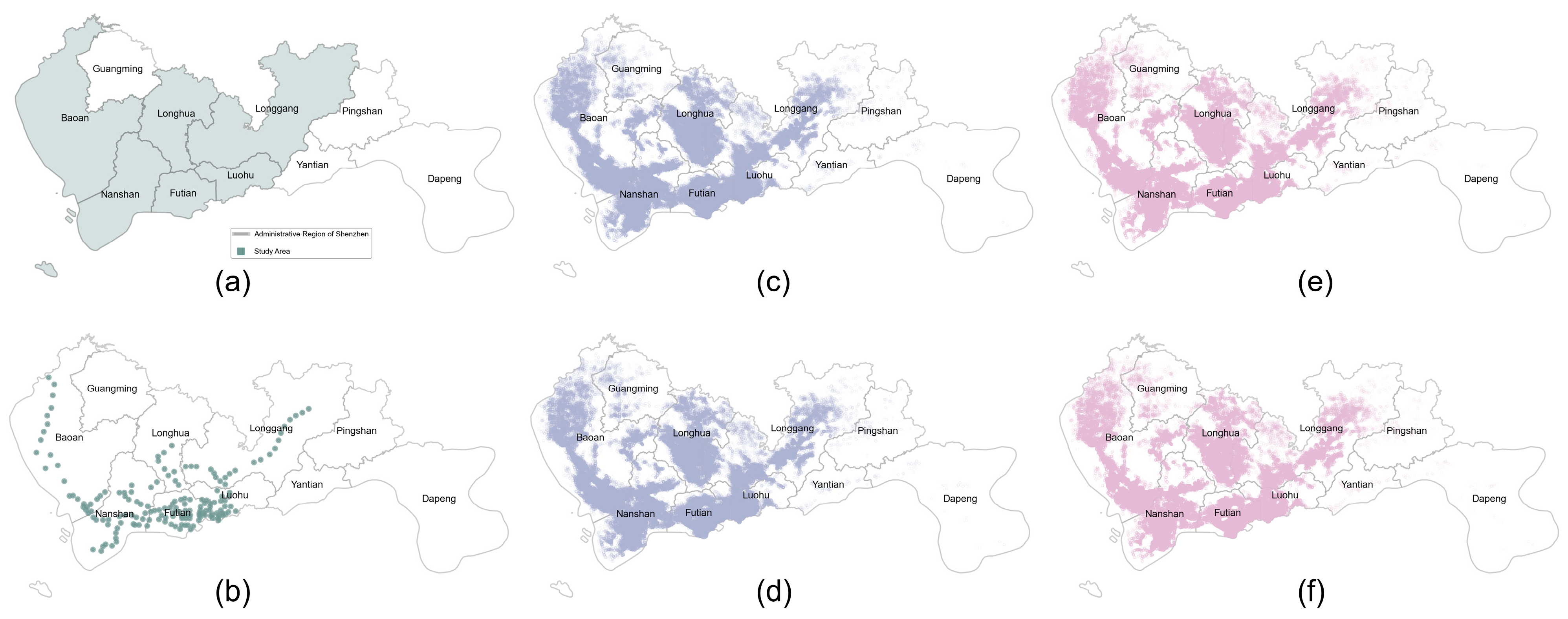

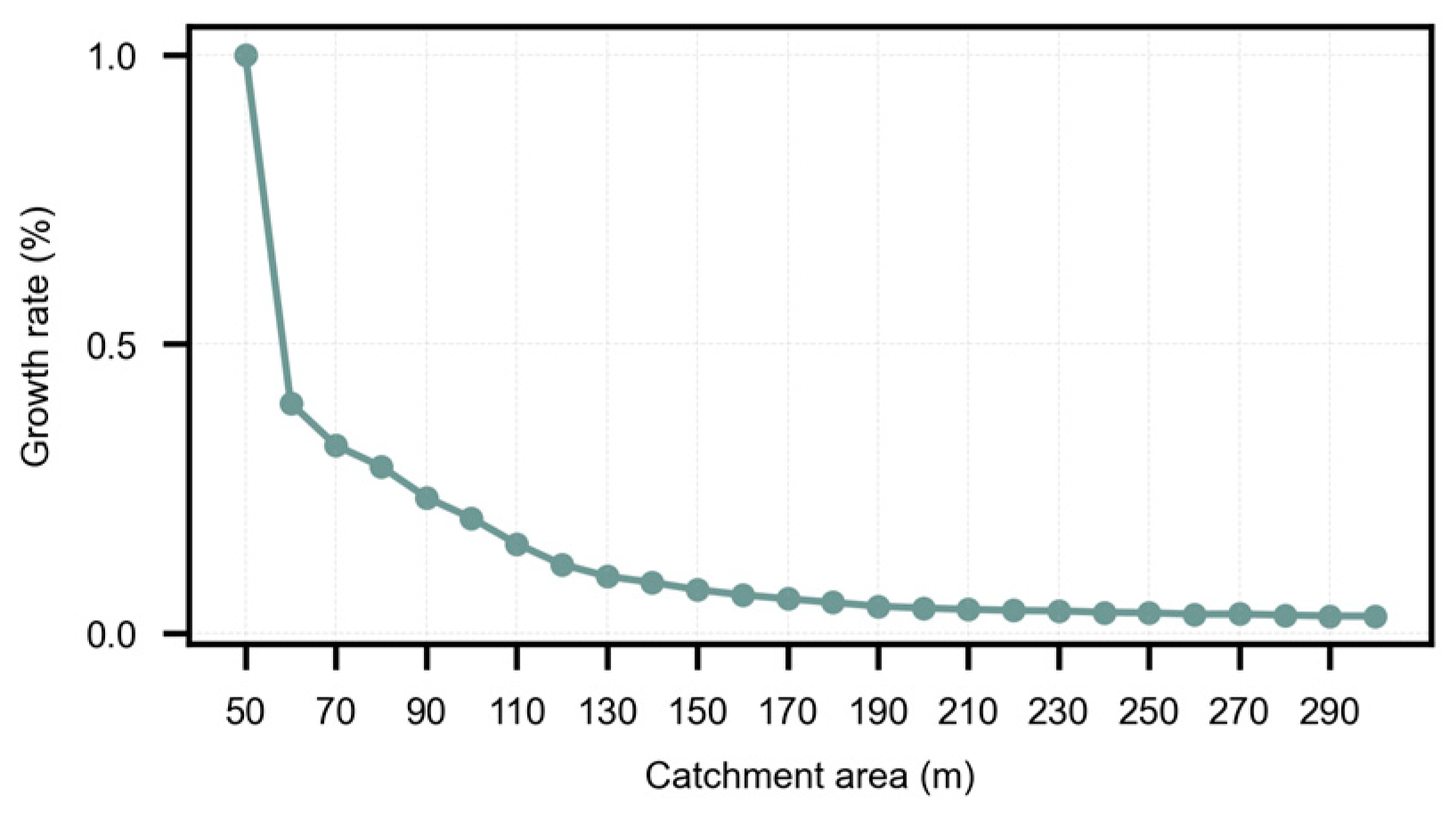
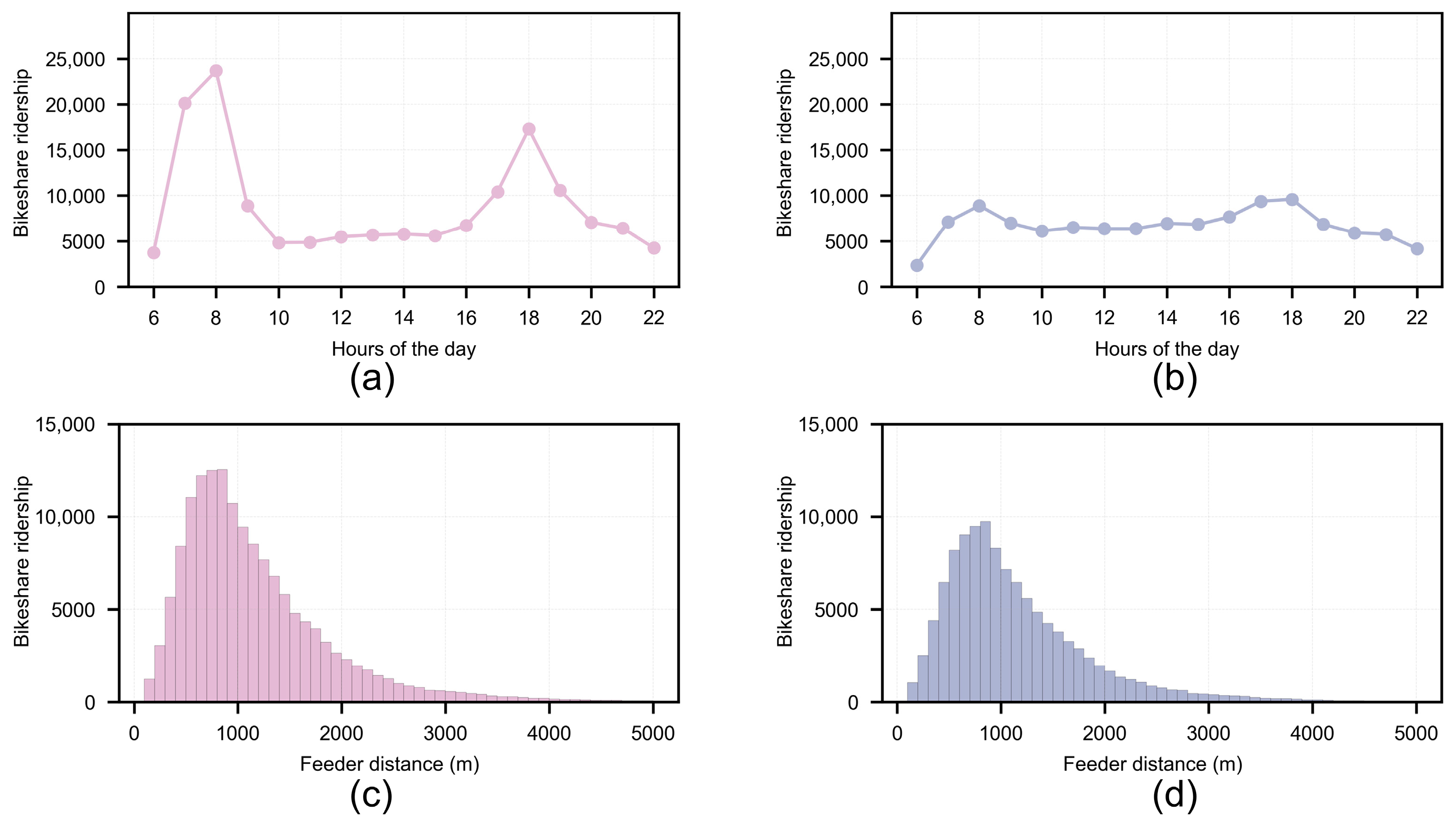
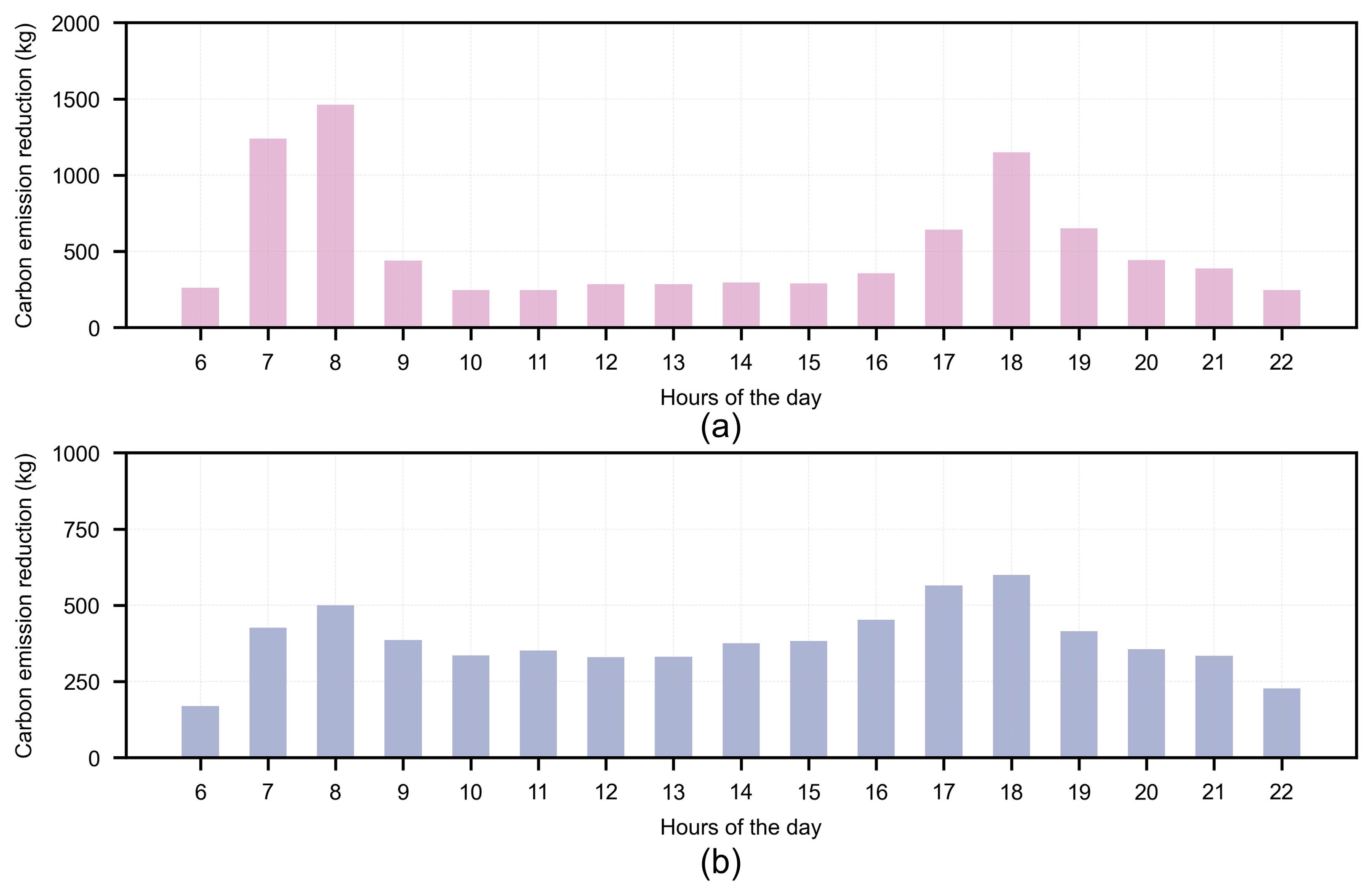

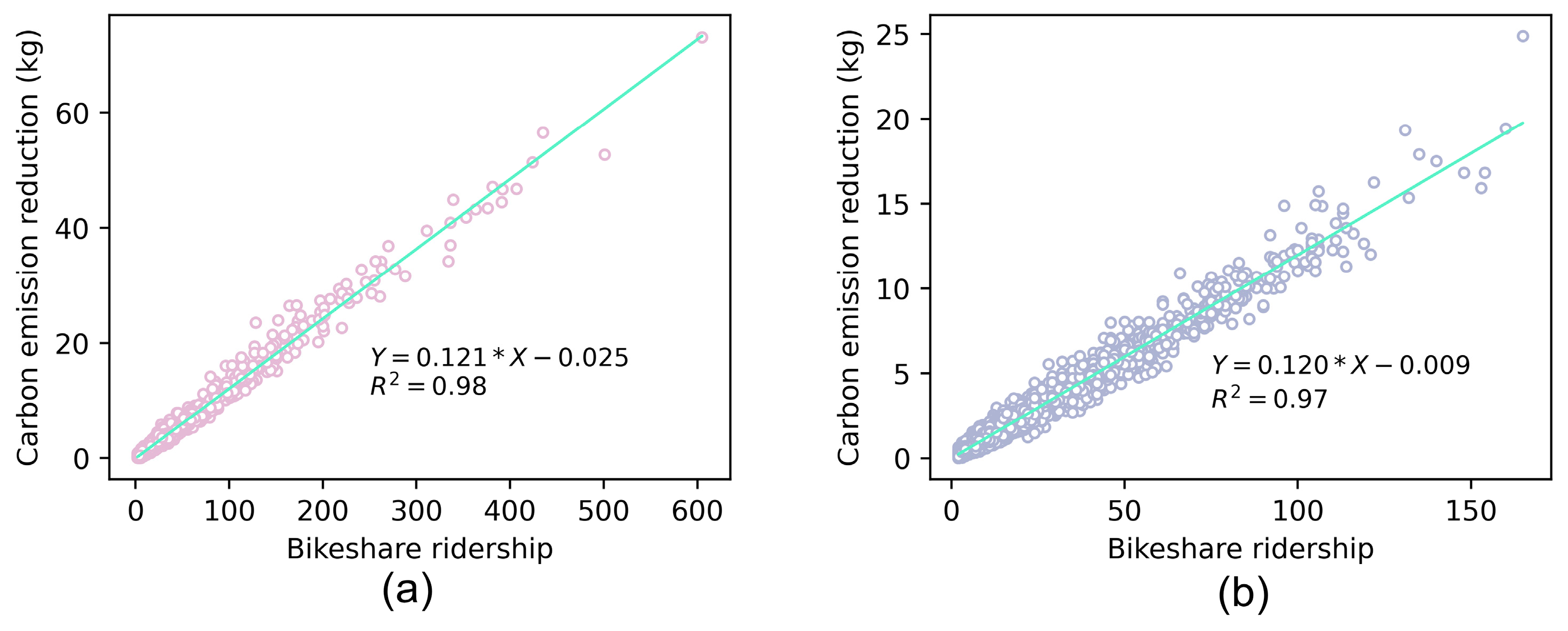
| Transport Mode | Bus | Subway | Taxi | Car | Other |
|---|---|---|---|---|---|
| Mode share | 18% | 20% | 5% | 53% | 4% |
Disclaimer/Publisher’s Note: The statements, opinions and data contained in all publications are solely those of the individual author(s) and contributor(s) and not of MDPI and/or the editor(s). MDPI and/or the editor(s) disclaim responsibility for any injury to people or property resulting from any ideas, methods, instructions or products referred to in the content. |
© 2024 by the authors. Licensee MDPI, Basel, Switzerland. This article is an open access article distributed under the terms and conditions of the Creative Commons Attribution (CC BY) license (https://creativecommons.org/licenses/by/4.0/).
Share and Cite
Li, H.; Wang, Z.; Wang, Q. Comparison of the Workday and Non-Workday Carbon Emission Reduction Benefits of Bikeshare as a Feeder Mode of Metro Stations. Appl. Sci. 2024, 14, 5107. https://doi.org/10.3390/app14125107
Li H, Wang Z, Wang Q. Comparison of the Workday and Non-Workday Carbon Emission Reduction Benefits of Bikeshare as a Feeder Mode of Metro Stations. Applied Sciences. 2024; 14(12):5107. https://doi.org/10.3390/app14125107
Chicago/Turabian StyleLi, Hao, Zhaofei Wang, and Qiuping Wang. 2024. "Comparison of the Workday and Non-Workday Carbon Emission Reduction Benefits of Bikeshare as a Feeder Mode of Metro Stations" Applied Sciences 14, no. 12: 5107. https://doi.org/10.3390/app14125107






